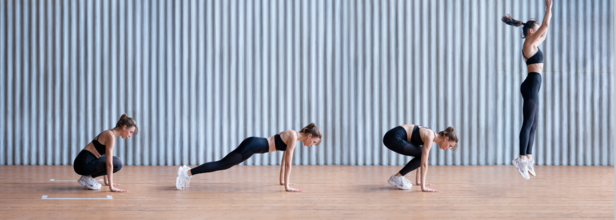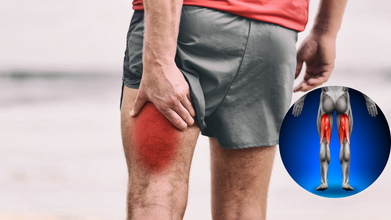- Health Conditions A-Z
- Health & Wellness
- Nutrition
- Fitness
- Health News
- Ayurveda
- Videos
- Medicine A-Z
- Parenting
- Web Stories
6 Different Burpee Variations For Your Daily Workout- Benefits And Step-By-Step Guide

6 Different Burpee Variations For Your Daily Workout- Benefits And Step-By-Step Guide
6 Different Burpee Variations For Your Daily Workout: There's nothing quite like burpees when it comes to effective, high-intensity exercises. Though the name may sound unusual and funny, burpees are in no way amusing; they are a great strength and cardio workout in one seamless motion. Whether you're a novice or an experienced athlete, burpees can really push your limits, improve your endurance, and burn calories.
In this guide, we’ll delve into the benefits of burpees, explore their step-by-step execution, and introduce six exciting variations to level up your fitness game.
Benefits of Burpees
1. Burns Calories Fast
Burpees are very calorie-intensive. You can burn approximately 10-15 calories per minute if you do this exercise at a moderate pace. That makes it a perfect exercise for weight loss and burning fat.
2. Full Body Exercise
Burpees work out a lot of muscles in the body, including the legs, glutes, core, chest, arms, and shoulders. This makes them a perfect exercise for building strength and body toning.
3. Improves Cardiovascular Fitness
Burpees do involve HIIT, and research has proven that such exercises improve cardiovascular fitness. HIIT also burns resistant fat, especially around the abdomen.
4. Easy and Equipment-free
You can perform burpees anywhere-from a home to a park and even in a hotel room. You only need your own body weight and some room.
How to Do a Burpee: Step-by-Step
You should first master a basic burpee before moving forward to variations. Follow these steps:
1. Stand with feet shoulder-width apart and keep arms by your sides.
2. Bend your knees and lower into a squat, placing your hands on the floor.
3. Jump your legs back into a high plank position. Keep your core tight and body straight.
4. Perform a push-up, lowering your chest to the floor.
5. Jump your legs forward to return to the squat position.
6. Jump into the air with your arms above your head.
7. Step straight back into the next repetition and land softly.
6 Burpee Variations to Try
1. Classic Full Burpee
The foundation for all variations, it's simple yet challenging: offering a great blend of cardio and strength.
2. Box Jump Burpee
Take your burpee to the next level by adding a box jump. Perform a standard burpee, but instead of jumping, explode up and leap onto a box or platform. This variation builds explosive power and increases lower-body strength.
3. Burpee to Lunge
Add a lunge to hit your glutes, quads, and hamstrings.
- After the push-up, jump your feet forward and stand.
- Step into alternating lunges before proceeding to the next rep.
4. Burpee With Dumbbells
This weighted variation adds resistance for greater strength development.
Hold dumbbells while performing the burpee, and finish with an overhead press for added intensity.
5. Burpee With Mountain Climbers
Add core engagement and cardio by including mountain climbers.
After doing the push-up, maintain a plank position and perform 5-10 mountain climbers before getting back to the squatting position.
6. Burpee With Star Jump
Add some explosiveness to your burpee by using a star jump.
Instead of a jump, leap into the air with all limbs extended like a star.
Although burpees look pretty intimidating, the benefits behind them make them worth every effort. They are multifunctional, equipment-free, and can be adapted according to the fitness level required. Start with the regular burpee to build your strength and endurance, then explore the variations to keep challenging your workouts.
Fact Check: Do Stronger Thigh Muscles Really Mean That You Live Longer?

Credits: Canva
Thanks to social media, now every one is a fitness influencer. However, not everything people say on social media is true, nevertheless social media did benefit many, allowing easy access on health and fitness. But whatever we see on the platform must be always taken with a pinch of salt.
One such video which is trending is of actor Ram Kapoor, who once was 140kg and then went on to lose 55kgs in 18 months. He has, ever since become an inspiration for many to lose weight naturally. As per him, having two simple meals a day and intermittent fasting principles helped him. Now, as somebody who influence people achieving their own fitness goals, especially that he himself has experienced it, he does not shy away from talking about it.
Also Read: Is Huntington’s Disease Genetic? Here’s Everything You Should Know
In one such conversation, he reveals that people in the insurance industry hire insurance experts to predict the age of a person and when he is going to die. One such man is Gary Brecka, a human biologist, and expert in science of human performance. Kapoor says, "He has an 82% accurate record in predicting one's longevity, based on the last 5 years of their life history."
Kapoor also notes that now he uses this experience he has gained from insurance industry to help people lead a better and healthy life.
"Do you know how he correlates the age till one will live?" Kapoor asks, "Through your thigh muscles."
Kapoor says that the stronger your thigh muscle is, the longer you will live. "When you sit, you need this muscle to get up. In India, everyone makes an upper body, but you do not need biceps to stand up," he said.
"Secondly, when you are 80 years old, it is very easy to trip and fall and if your leg muscles are not strong, you will have to have a hip replacement surgery, which is the beginning of the end. The person who underwent that surgery could only live for 5 to 6 years more."
Are Thighs Really The Key Predictor Of Longevity?
This is not the first time someone is talking about how thighs can help someone predict their age of living. Simon Sinek, an American author, international speaker, and more, also seconds this theory.
"Historically, thighs are the most important muscle responsible for notion." However, he correlates it with friendship. He says before cars, if you had to go meet a friend you would take a train or walk, which will put your thigh muscles at work, this means you have friends and to meet them you are mobile, "which means you are more likely to live longer".
Is There Any Truth In This?
While stronger thigh muscles could be one of the key predictors, the reason is not because it means you have a friendship or that a hip replacement surgery would only let you live 5 to 6 years afterwards.
As per the Harvard Health Publishing, researchers found that people with big thighs had a lower risk of heart diseases and premature death than those with thick thighs.
Also Read: What Does Trump's Latest Health Checkup Reveal About Him?
The real reason is because stronger thigh muscles, or leg muscles reduce risk of all cause and heart-relate mortality. In men, specifically, it could predict the age for how long do they live, notes a 2011 study published in Author Manuscript. Strong thighs improve stability, reduce risk of falls. This also supports daily functional activities, which seems to have reduced as age progresses. Also subcutaneous fat in thighs can provide protective effects for bone and bone strength and cardiovascular health, also notes Dr Kunal Sood, MD, and double board certified anesthesiology and international pain medicine, based in Maryland, US.
Note: The information in this article is based solely on observations and insights from the referenced videos. It does not, in any way, claim to define or predict a specific lifespan for anyone.
Struggling with Irregular Periods? Try These 5 Yoga Poses to Regulate Your Menstrual Cycle

Credits: Canva
The fast-paced lives of women today, whether it’s school exams, college projects, work deadlines, or managing countless household chores can cause significant stress, leaving both the body and mind drained. Prolonged stress isn’t just exhausting, it can also affect physical health, mental well-being, and hormonal balance, which in turn can disrupt one of the key functions of the female body, which is the menstrual cycle.
Can Stress Disrupt Your Menstrual Cycle?
Medically known as menstruation, the menstrual cycle involves shedding the uterine lining (endometrium) through vaginal bleeding. Typically, cycles occur every 28 days, though slight variations are normal. However, gynecologists in India and across the globe are seeing an increasing number of women reporting irregular periods, a trend that is cause for concern.
Irregular cycles are generally defined as those occurring after gaps of more than 35 days or when the timing varies unpredictably each month. While irregular periods are common during teenage puberty or around menopause for women over 45, they can signal underlying issues in women in their twenties and thirties, requiring proper medical attention.
Other Factors That Can Lead To Irregular Menstrual Cycle
Beyond stress, other factors contributing to irregular periods include sudden weight changes, excessive exercise, emotional challenges, medication side effects, and chronic conditions like diabetes or hypertension. Timely medical care is essential because irregular cycles can sometimes indicate serious conditions, including polycystic ovarian syndrome (PCOS), endometriosis, or even cervical cancer. Symptoms often include heavy bleeding, spotting between periods, post-intercourse bleeding, menstrual bleeding in menopause, severe abdominal cramps, and extreme fatigue.
While medications and supplements can help balance hormones, Yoga, a centuries-old natural practice can complement medical treatment by promoting overall reproductive health and helping regulate menstrual cycles. Yoga combines stationary postures, stretching movements, and controlled breathing to reduce stress, relax the body, calm the mind, and support reproductive function. Below are some effective yoga poses to help regulate your cycle and enhance women’s health.
Yoga for Irregular Periods
Matsyasana (Fish Pose)
Lie flat on your back with arms under your hips, elbows close to the waist. Bend your legs into a cross-legged position with knees and thighs touching the floor. Inhale and gently lift your upper body and the back of your head, hold for a few breaths, then exhale and relax.
Dhanurasana (Bow Pose)
Lie face down with feet slightly apart and arms by your sides. Bend your legs and hold your ankles, lifting your chest and legs off the floor while inhaling. Hold as long as comfortable, then slowly lower back down.
Adho Mukha Svanasana (Downward-Facing Dog Pose)
Start on all fours, hands straight and head facing forward, knees bent, feet on the floor. Exhale and lift your hips, straightening your arms and forming a V-shape. Hold for a few breaths, then return to the starting position.
Malasana (Garland Pose)
Squat on the floor with heels flat, thighs wide, and feet close together. Exhale and fold forward, placing your torso between the thighs. Bring elbows to the inner thighs, applying gentle pressure, lift heels slightly, then return to a relaxed squat.
Ustrasana (Camel Pose)
Kneel with heels flat, hands on hips, keeping knees and shoulders aligned. Inhale and arch your back, holding your feet for balance. Stay for about a minute, then return slowly to upright. Alongside professional care, medications, and a healthy diet, daily yoga and meditation can help regulate menstrual cycles.
Stress, whether physical, mental, or emotional, can trigger irregular periods. Work pressure, household responsibilities, or personal challenges may create tension, anxiety, or panic, disrupting hormonal balance. Doctors advise women to step back from stressful situations, practice deep breathing, stay hydrated, and get enough sleep to restore calm and support healthy menstrual cycles.
8 Pickleball Warm-Up Exercises To Avoid Injuries, According To Expert

Credits: Canva and Instagram
Pickleball and padel, a sport that has gained momentum across India, is changing everyone's lives and helping people stay fit and active. However, while the game has gained many enthusiasts, fitness experts are also warning that enthusiasm without preparation can come at a cost. As many are reporting sports-related injuries, especially while playing pickleball. Luke Coutinho, lifestyle guru and holistic wellness expert in his Instagram video claims that he has seen a surge in knee, elbow, and lower back injuries linked to the sport.
“Pickle and paddle are two of the fastest-growing sports across our country right now, great for longevity, hand-eye coordination, and overall fitness,” says Coutinho. “But what’s equally important is knowing how to look after your knees, glutes, and elbows.”
Also Read: The Ozempic 'Trick' Could Cause More Harm For Non-Diabetic And Fit People, According To Doctors
According to him, just five minutes of targeted warm-up can dramatically lower the risk of injury. Here are the eight quick exercises Coutinho recommends before every game.
Wall Sit Toe Raises
You can start this exercise by leaning against a wall, sliding down until your thighs are parallel to the ground. Imagine as if you are sitting on an invisible chair. Keep your back as flat as you can against the wall. Coutinho says that this will "protect your knees and prevent shin splints."
How to do it:
- Hold this position and lift your toes upward while keeping your heels on the ground.
- Lower them back down slowly.
Why it helps: Strengthens the muscles in your shins and stabilizes the knees, helping prevent shin splints and knee strain.
Wall Sit Calf Raises
Coutinho suggests that you can follow up by this exercise. You can start from the same wall-sit position. This variation focuses on the calves and ankles.
How to do it:
- Keep your back flat against the wall, feet shoulder-width apart.
- Lift your heels up as high as possible, balancing on your toes.
- Slowly lower and repeat.
Why it helps: Builds ankle strength and lower leg stability, Coutinho suggests that it is the key for all those quick lateral pickleball movements.
Wall Knee Extensions
- Stay in the wall sit and extend one leg straight out in front of you.
- Hold for two seconds, then switch legs.
"It engages your quadriceps and enhances knee stability, reducing the risk of ligament tears," he points out.
Dynamic Lunges with Overhead Reach
While lunges are a great way to ensure mobility and flexibility, a little bit of modification could lead to a full-body stretch, along with balance training.
How to do it:
- Step forward into a lunge, keeping your front knee above your ankle.
- Raise both arms overhead as you lower your body.
- Push back to starting position and switch sides.
Why it helps: Opens your hips and chest while activating major leg muscles, prepping your core for rotational movements during play.
Mini Band Side Walks
How to do it:
- Place a resistance band just above your knees.
- Bend slightly at your hips and knees, then step sideways.
- Take 10 steps in one direction, then back.
Why it helps: Strengthens the glutes and prevents the knees from collapsing inward during sudden lateral shifts.
High Knees
This is probably the easiest, and one of the most common exercises anyone will encounter, especially while playing sports. It is a great way to warm up or cool down your body after a strenuous workout.
How to do it:
- Start by jogging in place, and bring your knees high, towards your chest.
Why it helps: It improves agility, coordination, and cardiovascular readiness before fast-paced rallies.
Knee Side Raises
How to do it:
- Stand upright, lift one knee out to the side, hold briefly, and lower it down.
- Repeat on the other side.
Why it helps: Builds lateral hip strength and enhances balance, crucial for sidesteps and quick turns.
Kickbacks
How to do it:
- Stand tall, kick one leg straight back without arching your back.
- Engage your glutes and hamstrings as you lift.
Why it helps: Activates the glutes and hamstrings, adding power to your movements and reducing lower back strain.
“Do 10 reps on each side, and you’re game-ready, explosive and injury-proof,” Coutinho says. “Looking after your health to prevent injury is the first step toward holistic wellness and longevity.” As he rightly says, "These warm-ups aren't optional, they are essential."
© 2024 Bennett, Coleman & Company Limited

